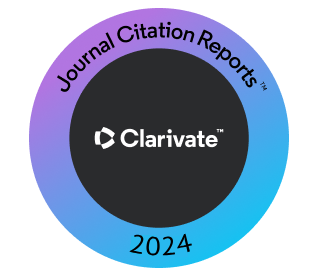Dual-Band Power Divider with Wide Suppression Band
Artificial Intelligence Modeling for Performance Confirmation
DOI:
https://doi.org/10.14500/aro.11945Keywords:
Dual band Wilkinson power divider, Harmonic suppression, Neural network, ResonatorAbstract
In this paper, a planar dual-band Wilkinson power divider (DWPD) with a triangular-shaped resonator is designed. This work stands out from existing designs by addressing key limitations in conventional power dividers, i.e., physical size, harmonic suppression, and insertion loss. The proposed triangular shaped resonator has a compact size of 9.9 mm × 3.4 mm (0.26 λg × 0.09 λg ), where λg is electrical wavelength at 5.9 GHz, and provides a wide suppression band from 7.1 GHz to 20.6 GHz with a 20 dB attenuation level. In the proposed DWPD structure, two triangular shaped resonators are used in two branches. It works at 3.6 GHz and 5.5 GHz with <0.1 dB insertion loss at both operating bands. The input and output return losses and ports isolation parameters at both bands are better than 20 dB, which show good performance of the divider at operating bands. Besides the acceptable performance, the proposed DWPD provides a wide suppression band from 6.8 GHz to 20.5 GHz with more than 20dB attenuation level. In the divider design, the neural network is employed to model a triangular-shaped resonator. The proposed neural network has two outputs (S11 and S21), and two hidden layers with eight neurons at each layer. The weights of each neuron are obtained using particle swarm optimization algorithms. The proposed neural network model has accurate results, and the mean relative error of the train and test data for both outputs is <0.1 , which validates the accurate results of the proposed model.
Downloads
References
Ahmed, U., and Abbosh, A., 2015. Modified Wilkinson power divider using coupled microstrip lines and shunt open-ended stubs, Electronics Letters, 51(11), pp.838-839. DOI: https://doi.org/10.1049/el.2015.0595
Armstrong, J., and Collopy, F., 1993. Error measures for generalizing about forecasting methods: Empirical comparisons. International Journal of Forecasting, 8(1), 69-80. DOI: https://doi.org/10.1016/0169-2070(92)90008-W
Bavandpour, S.K., Roshani, S., Pirasteh, A., Roshani, S., and Seyedi, H., 2021. A compact lowpass-dual bandpass diplexer with high output ports isolation. AEU-International Journal of Electronics and Communications, 135, pp.153748. DOI: https://doi.org/10.1016/j.aeue.2021.153748
Cheng, K.K.M., and Ip, W.C., 2010. Anovel power divider design with enhanced spurious suppression and simple structure. IEEE Transactions on Microwave Theory and Techniques, 58(12), pp.3903-3908. DOI: https://doi.org/10.1109/TMTT.2010.2086473
Cheng, K.K.M., and Law, C., 2008. A novel approach to the design and implementation of dual-band power divider. IEEE Transactions on Microwave Theory and Techniques, 56(2), pp.487-492. DOI: https://doi.org/10.1109/TMTT.2007.914629
Heydari, M., and Roshani, S., 2017. Miniaturised unequal Wilkinson power divider using lumped component elements. Electronics Letters, 53(16), pp.1117-1119. DOI: https://doi.org/10.1049/el.2017.2118
Heydari, M., Rostami, P., and Roshani, S., 2019. Design of a modified wilkinson power divider with size reduction and harmonics suppression using triangleshaped resonators. Wireless Personal Communications, 109(3), pp.1571-1579. DOI: https://doi.org/10.1007/s11277-019-06628-z
Huang, W., Liu, C., Yan, L., and Huang, K., 2010. A miniaturized dual-band power divider with harmonic suppression for GSM applications. Journal of Electromagnetic Waves and Applications, 24(1), pp.81-91. DOI: https://doi.org/10.1163/156939310790322082
Jamshidi, M., Lalbakhsh, A., Lotfi, S., Siahkamari, H., Mohamadzade, B., and Jalilian, J., 2020. Aneuro-based approach to designing a Wilkinson power divider. International Journal of RF and Microwave Computer‐Aided Engineering, 30(3), pp.e22091. DOI: https://doi.org/10.1002/mmce.22091
Jamshidi, M., Siahkamari, H., Roshani, S., and Roshani, S., 2019. A compact gysel power divider design using U-shaped and T-shaped resonators with harmonics suppression. Electromagnetics, 39(7), pp.491-504. DOI: https://doi.org/10.1080/02726343.2019.1658165
Liang, J.G., and Xu, H.X., 2012. Harmonic suppressed bandpass filter using composite right/left handed transmission line. Journal of Zhejiang University Science C, 13(7), pp.552-558. DOI: https://doi.org/10.1631/jzus.C1100386
Lin, C.M., Su, H.H., Chiu, J.C., and Wang, Y.H., 2007. Wilkinson power divider using microstrip EBG cells for the suppression of harmonics. IEEE Microwave and Wireless Components Letters, 17(10), pp.700-702. DOI: https://doi.org/10.1109/LMWC.2007.905595
Lotfi, S., Roshani, S., and Roshani, S., 2020. Design of a miniaturized planar microstrip Wilkinson power divider with harmonic cancellation. Turkish Journal of Electrical Engineering and Computer Sciences, 28(6), pp.3126-3136. DOI: https://doi.org/10.3906/elk-1911-104
MahdiAbadi, S., Roshani, S., Parandin, F., and Roshani, S., 2024. Design of a miniaturized 90-degree quadrature hybrid coupler with harmonic suppression ability using π-shaped lumped elements. Scientific Reports, 14(1), pp.26489. DOI: https://doi.org/10.1038/s41598-024-78328-z
Mohammadi, N., Moloudian, G., Roshani, S., Roshani, S., Parandin, F., and Lalbakhsh, A., 2024. A Wilkinson power divider with harmonic suppression through low-pass filter for GSM and LTE applications. Scientific Reports, 14(1), pp.2429. DOI: https://doi.org/10.1038/s41598-024-52506-5
Pirasteh, A., Roshani, S., and Roshani, S., 2020. Design of a miniaturized class F power amplifier using capacitor loaded transmission lines. Frequenz, 74(3-4), pp.145-152. DOI: https://doi.org/10.1515/freq-2019-0180
Roshani, S., Dehghani, K., and Roshani, S., 2019a. Alowpass filter design using curved and fountain shaped resonators. Frequenz, 73(7-8), pp.267-272. DOI: https://doi.org/10.1515/freq-2019-0013
Roshani, S., Golestanifar, A., Ghaderi, A., Siahkamari, H., and Abbott, D., 2018. High performance microstrip low pass filter for wireless communications. Wireless Personal Communications, 99, pp.497-507. DOI: https://doi.org/10.1007/s11277-017-5123-1
Roshani, S., Hayati, M., Setayeshi, S., Roshani, S., and Mohamadpour, G., 2016. A miniaturized harmonic suppressed power amplifier integrated with lowpass filter for long term evolution application. Analog Integrated Circuits and Signal Processing, 89, pp.197-204. DOI: https://doi.org/10.1007/s10470-016-0816-z
Roshani, S., Jamshidi, M.B., Mohebi, F., and Roshani, S., 2021. Design and modeling of a compact power divider with squared resonators using artificial intelligence. Wireless Personal Communications, 117, pp.2085-2096. DOI: https://doi.org/10.1007/s11277-020-07960-5
Roshani, S., Koziel, S., Roshani, S., Hashemi Mehr, F.S., and Szczepanski, S., 2022. Design and implementation of a dual-band filtering Wilkinson power divider using coupled T-shaped dual-band resonators. Energies, 15(3), pp.1189. DOI: https://doi.org/10.3390/en15031189
Roshani, S., Koziel, S., Yahya, S.I., Chaudhary, M.A., Ghadi, Y.Y., Roshani, S., and Golunski, L., 2023. Mutual coupling reduction in antenna arrays using artificial intelligence approach and inverse neural network surrogates. Sensors, 23(16), pp.7089. DOI: https://doi.org/10.3390/s23167089
Roshani, S., Roshani, S., and Zarinitabar, A., 2019b. A modified Wilkinson power divider with ultra harmonic suppression using open stubs and lowpass filters. Analog Integrated Circuits and Signal Processing, 98(2), pp.395-399. DOI: https://doi.org/10.1007/s10470-018-1299-x
Rostami, P., and Roshani, S., 2018. A miniaturized dual band Wilkinson power divider using capacitor loaded transmission lines. AEU-International Journal of Electronics and Communications, 90, pp.63-68. DOI: https://doi.org/10.1016/j.aeue.2018.04.014
Srisathit, S., Chongcheawchamnan, M., and Worapishet, A., 2003. Design and realisation of dual-band 3 dB power divider based on two-section transmissionline topology. Electronics Letters, 39(9), pp.723-724. DOI: https://doi.org/10.1049/el:20030483
Tang, C.W., and Chen, J.T., 2016. A design of 3-dB wideband microstrip power divider with an ultra-wide isolated frequency band. IEEE Transactions on Microwave Theory and Techniques, 64(6), pp.1806-1811. DOI: https://doi.org/10.1109/TMTT.2016.2554552
Wang, X., Ma, Z., Yoshikawa, M., Kohagura, J., Tokuzawa, T., Kuwahara, D., and Mase, A., 2017. Mixed π type structure in W ilkinson power divider design with 3rd harmonic suppression. Microwave and Optical Technology Letters, 59(6), pp.1245-1248. DOI: https://doi.org/10.1002/mop.30513
Wang, X., Sakagami, I., Mase, A., and Ichimura, M., 2014a. Trantanella Wilkinson power divider with additional transmission lines for simple layout. IET Microwaves, Antennas and Propagation, 8(9), pp.666-672. DOI: https://doi.org/10.1049/iet-map.2013.0454
Wang, X., Sakagami, I., Mase, A., and Ichimura, M., 2014b. Wilkinson power divider with complex isolation component and its miniaturization. IEEE Transactions on Microwave Theory and Techniques, 62(3), pp.422-430. DOI: https://doi.org/10.1109/TMTT.2014.2300835
Willmott, C.J., and Matsuura, K., 2005. Advantages of the mean absolute error (MAE) over the root mean square error (RMSE) in assessing average model performance. Climate Research, 30(1), pp.79-82. DOI: https://doi.org/10.3354/cr030079
Woo, D.J., and Lee, T.K., 2005. Suppression of harmonics in Wilkinson power divider using dual-band rejection by asymmetric DGS. IEEE Transactions on Microwave Theory and Techniques, 53(6), pp.2139-2144. DOI: https://doi.org/10.1109/TMTT.2005.848772
Wu, L., Sun, Z., Yilmaz, H., and Berroth, M., 2006. Adual-frequency Wilkinson power divider. IEEE Transactions on Microwave Theory and Techniques, 54(1), pp.278-284. DOI: https://doi.org/10.1109/TMTT.2005.860300
Wu, L., Yilmaz, H., Bitzer, T., and Berroth, A.P.M., 2005. A dual-frequency Wilkinson power divider: For a frequency and its first harmonic. IEEE Microwave and Wireless Components Letters, 15(2), pp.107-109. DOI: https://doi.org/10.1109/LMWC.2004.842848
Yahya, S.I., Alameri, B.M., Jamshidi, M., Roshani, S., Chaudhary, M.A., Ijemaru G.K., Mezaal, Y.S., and Roshani, S., 2022. A new design method for class-E power amplifiers using artificial intelligence modeling for wireless power transfer applications. Electronics, 11(21), pp.3608. DOI: https://doi.org/10.3390/electronics11213608
Yahya, S.I., Zubir, F., Hussin, F.A., Chaudhary, M.A., Roshani, S., Sadeghin, J., Jizat, N.M., and Roshani, S., 2024. Design of a compact power splitter with improved performance for wireless applications using recurrent and feed forward neural networks inverted models. IEEE Access, 12, pp.117056-117071. DOI: https://doi.org/10.1109/ACCESS.2024.3449137
Downloads
Published
How to Cite
Issue
Section
License
Copyright (c) 2025 Salman Karimi, Golshan Mohamadpour, Saeed Roshani

This work is licensed under a Creative Commons Attribution-NonCommercial-ShareAlike 4.0 International License.
Authors who choose to publish their work with Aro agree to the following terms:
-
Authors retain the copyright to their work and grant the journal the right of first publication. The work is simultaneously licensed under a Creative Commons Attribution License [CC BY-NC-SA 4.0]. This license allows others to share the work with an acknowledgement of the work's authorship and initial publication in this journal.
-
Authors have the freedom to enter into separate agreements for the non-exclusive distribution of the journal's published version of the work. This includes options such as posting it to an institutional repository or publishing it in a book, as long as proper acknowledgement is given to its initial publication in this journal.
-
Authors are encouraged to share and post their work online, including in institutional repositories or on their personal websites, both prior to and during the submission process. This practice can lead to productive exchanges and increase the visibility and citation of the published work.
By agreeing to these terms, authors acknowledge the importance of open access and the benefits it brings to the scholarly community.
Accepted 2025-01-15
Published 2025-02-01
















 ARO Journal is a scientific, peer-reviewed, periodical, and diamond OAJ that has no APC or ASC.
ARO Journal is a scientific, peer-reviewed, periodical, and diamond OAJ that has no APC or ASC.